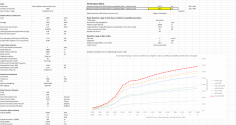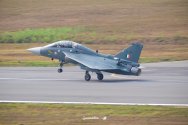Apparently you can get your Twitter account blocked in India for criticising a ship's design. Our favourite HK'er who did just that got his account banned in India lmao. I also like how the dude is celebrating criticism being silenced as if it an own against our HK'er friend.
You are using an out of date browser. It may not display this or other websites correctly.
You should upgrade or use an alternative browser.
You should upgrade or use an alternative browser.
Indian Military News, Reports, Data, etc.
- Thread starter bd popeye
- Start date
Lethe
Captain
Images of the ditched Naval ALH IN709 floating on the water last month brought a lump to my throat. My unit the ALH Flight was supposed to have accepted that helicopter in 2008, but further acquisition was put on hold since the Navy didn’t find the ALH was yet up to the mark for shipborne utilisation.
Having commanded the ALH unit in the Navy between 2005 – 2008 I was closely associated with Hindustan Aeronautics Limited (HAL) during those crucial years. All of us were proud to be flying the first Indian built helicopter, keen to take it to the limits and define operational parameters. The first big sign of trouble was in Nov 2005 when the HAL pilots ferrying the civil ALH crash-landed near Hyderabad because the tail rotor had sheared off. Signs of this failure were clearly seen earlier during our embarkation on the Carrier in 2005. HAL chose to “replace and fly” our damaged tail rotor, rather than do a thorough study and get to the root of the problem.
Problems with the initial Limited Series Production models, like MGB rejections, rainwater pouring inside the cockpit, airframe parts flying off, etc should have been fixed before going into Series Production. Many of these related to both design and quality of workmanship so this is unlikely to have changed. HAL’s claim that all problems are fixed does not inspire confidence because of continued accidents and quality issues even on the new machines. There must have been many near-accidents in which the helicopter was not a write-off due to sheer providence and so these will never come to light. The last two crashes in quick succession on 08 and 26 March are new frames of the Mark III variant that too with very little flying on them.
Dhruv was developed jointly with the MBB design bureau using a radical gearbox design that nobody else uses. Probably this very design applied to a 6 ton class machine, with the high hinge offset and vibrations is the source of problems. It is time to re-look and perhaps start on a blank slate with all the experience gained.
Context: it was announced that ALH/Dhruv would fulfil the Indian Navy's utility helicopter requirement for 60 aircraft.
from HAL test pilot in 2020:
None of the naval pilots have flown or assessed the current generation ALH. It’s sad that with 16 ALH in the pipeline, the Naval Project Team at HAL does not have a Test Pilot or a Test Engineer on its strength. The last Test Crew was posted to the project team some 6-8 years back and that too with no mandate to participate in the ongoing ALH flight trials. Compare this to the Air Force and the Army which have a dedicated team of Test Pilots and Test Engineers co-located with HAL flight ops. These test crew participate in all the flight trials and are abreast with the current progress on them, thereby keeping the respective Service HQs updated on the changes/progress made on each program and if required provide service inputs so that they are addressed at an early stage in the program. On the naval side, the role of the project team is reduced only to following up on the aircraft that come here for maintenance. There is no one to advise NHQ on what exactly HAL’s current capability is and how it has improved over the years. So, most of what you get is hearsay.
All the not-so-good comments that have been made recently are based on the ALH of the year 2000, and out of experience of operating the limited ALH (Mk1s) that are in the Indian naval inventory [.....] ALH was specifically designed for high altitude and some intensive manoeuvring which are exactly opposite to what the Indian Navy needed. Naval aircraft primarily need long period hover (time on station) and stability, which is the opposite of manoeuvrability. The design requirements were on the opposite ends of the spectrum hence there was no way that ALH would have met the NSQR. It’s easy to say in hindsight that HAL should have used a different rotor for the Naval ALH. As a nation in the 1990s we did not have any background in helicopter design, we were just learning to take baby steps, there was no margin within the project to make two different helicopters.
Also, the lead service for ALH were Army and Air Force (compare their numbers with Naval requirement); their requirements were for Siachen heights and an extraordinary requirement of a max 3.5 ‘g’ limit. The performance requirement was genuine however all other requirements were taken from other contemporary helicopters of that era (BO 105/BK 117). The 3.5 g requirement and battlefield survivability for controls were the major factors affecting the design of the rotor and the rotor head. To enable ALH to make such high ‘g’ maneuvers the rotor had a large hinge offset which was partly accomplished by the large rotor head. The large rotor mast also accommodated the controls which passed through the centre of the MGB. With a large rotor head, the ALH with its blades folded became too big to manoeuvre into the ship hangars.
hmm found this in Indian defense related tweet.
I would say 1600 TRM is kind of a downer but well i think it's better than 1200 previously advertised in some Indian defense related site (e.g global defense corp). The commenter claim that the module would be GaAs based, probably why the TRM counts is rather low as perhaps to meet the emitted power requirement they could be using multiple GaAs amplifier stages or the MMIC chipset are just that big. Thus drive the size of the TRM.
Previously i made an estimate of range based on the published specification of the VCM system for the AESA's. With assumption of 2000 TRM's a reasonable counts for N011M bars sized antenna.

Which yields range estimates of 249 km with PD-90% and Pfa of 8.3*10^-15. Assuming same radar but with lesser module counts. Would yield 15% lower performance or about 211-212 Km range against the same target with sama PD.
This performance is superior to N011M Bars India possessed, bit lower but not that much compared to Irbis-E, still allow something like RVV-BD to be used with impunity. Remains to be seen however if India would be interested in developing such long range AAM's. In order to gain the "lost" 15% performance the TRM's power must be increased twice, which could make the module more expensive.
I would say 1600 TRM is kind of a downer but well i think it's better than 1200 previously advertised in some Indian defense related site (e.g global defense corp). The commenter claim that the module would be GaAs based, probably why the TRM counts is rather low as perhaps to meet the emitted power requirement they could be using multiple GaAs amplifier stages or the MMIC chipset are just that big. Thus drive the size of the TRM.
Previously i made an estimate of range based on the published specification of the VCM system for the AESA's. With assumption of 2000 TRM's a reasonable counts for N011M bars sized antenna.

Which yields range estimates of 249 km with PD-90% and Pfa of 8.3*10^-15. Assuming same radar but with lesser module counts. Would yield 15% lower performance or about 211-212 Km range against the same target with sama PD.
This performance is superior to N011M Bars India possessed, bit lower but not that much compared to Irbis-E, still allow something like RVV-BD to be used with impunity. Remains to be seen however if India would be interested in developing such long range AAM's. In order to gain the "lost" 15% performance the TRM's power must be increased twice, which could make the module more expensive.
India doesn't even have basic facilities for Aviation.
for Air intake its France, and for engine testing they went to Russia.
Anybody know where such facilities are located for China? Is there a centralised location in 1 city like Shenyang/Chengdu/Xian or something?
India doesn't even have basic facilities for Aviation.
for Air intake its France, and for engine testing they went to Russia.
At least they have RCS range. But yeah they need to get some priority straight.
One of the commentator there mentioned that there is already such facilities in India but for some reason they dont know how to certify it. That's kinda sus tbh.
One of the commentator there mentioned that there is already such facilities in India but for some reason they dont know how to certify it. That's kinda sus tbh.
One thing from AMCA i noticed is the unusual Horizontal stabilizer/tailfin which more akin to an air-to-air missile than typical stealth aircraft.




